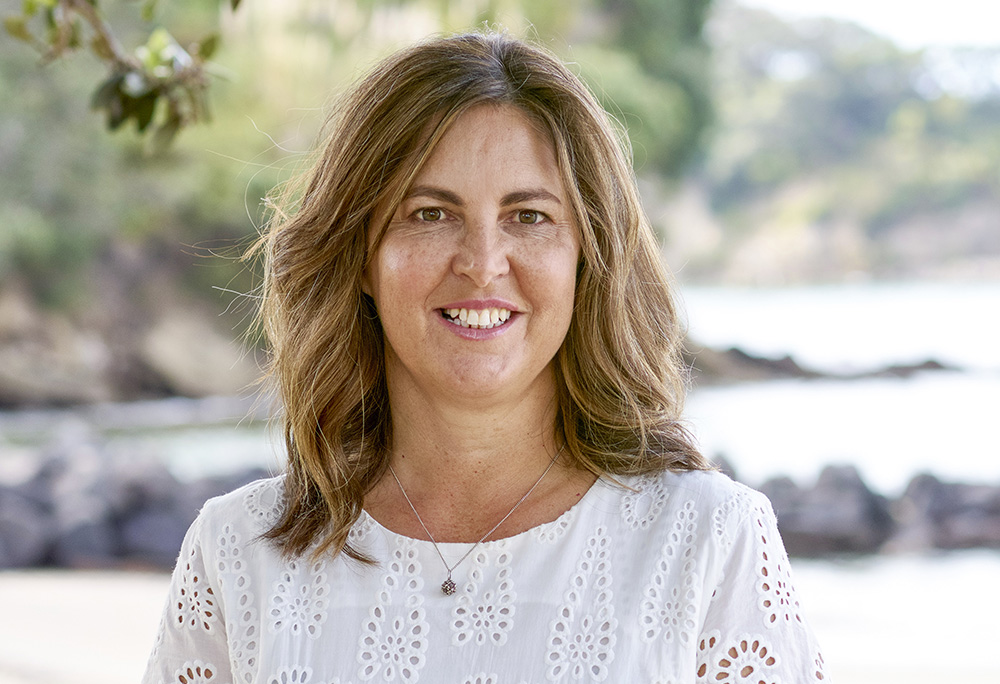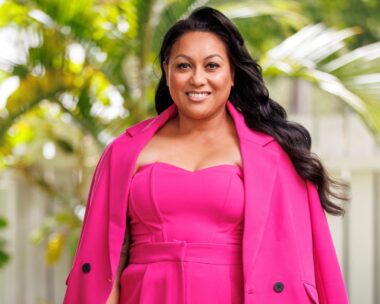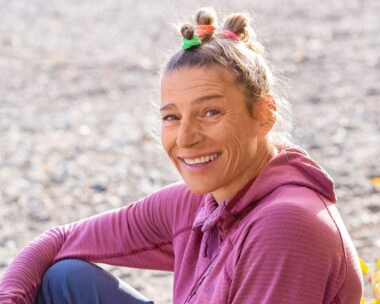On her 18th birthday in 1947, aspiring Dunedin long jumper Yvette Williams received an extra-large scrapbook.
Despite being told she would gain unsightly muscles if she carried on with athletics, her parents had proudly cut out newspaper articles from her season that needed a home. Yvette went to her bedroom, opened it at her desk and carefully wrote “My Sporting Life” onto the first page.
Being an athlete was an unorthodox choice for a young woman of that era. All her friends were getting married and having children. Her own boyfriend at the time wanted her to do the same.
But holding on to her dream, Yvette wrote in her diary: “One year today is the opening of the 1952 Olympic Games in Helsinki, so I just wonder if I’ll be there. Either that or doing housework, I suppose.”

All eyes were on the flying Kiwi when she won gold at the Helsinki Olympics in 1952
It’s this scrapbook and never-before-seen diaries that author Angela Walker has drawn on to recreate the day-to-day world of the late Kiwi icon in her new book Ideals Are Like Stars.
It coincides with the 70th anniversary of Dame Yvette Williams becoming the first New Zealand woman to win an Olympic gold medal – a feat not repeated until windsurfer Barbara Kendall won gold 40 years later.
Angela believes Yvette’s life story is one that is long overdue being told.
“I was absolutely flabbergasted there hadn’t been a book done on her before, when she’s well worthy of having her legacy in print,” she asserts.
“No one else had ‘forgotten’ to write the biographies of Peter Snell, Murray Halberg or John Walker – all of her male counterparts.”

Although up until now she never had a book written about her, Yvette had a lot of press coverage back in the day. Her story takes place against the backdrop of historic moments: VE Day, the Queen’s coronation and Edmund Hillary ascending Everest. She, too, created history by thrilling a nation after famously jumping 6.24 metres in Helsinki’s Olympic Stadium and inspiring other women of her generation to take a leap into sport.
In researching and writing Yvette’s story, Angela – herself a former Olympian – related to her experiences and discovered they shared many surprising links. Angela competed for New Zealand at the 1988 Olympic Games in Seoul, and later won a gold and three bronze medals competing at the 1990 Commonwealth Games.
“I really understood the life Yvette was leading, in terms of dedicating yourself to training every day,” says the 55-year-old, who is mum to son Sachin, 15.

Like Yvette, Angela was a gold medallist and they even had the same coach
“She would talk about the terror of having to give a speech and I remember that fear as a teenager of having to talk at my local Rotary club. It was terrifying!
“Remarkably, we also had the same coach, Mrs Emmy Bellwood. She took on Yvette at the start of her coaching career and me near the end of it.”
Angela recalls meeting Yvette for the first time as a star-struck teenager.
“We were at a cocktail party for the gymnastics community,” she recalls. “Yvette’s daughter Karen Corlett was also a national rhythmic gymnastics representative, so that’s why she was there. It seems fitting now that I know how much Yvette loved a good party,” smiles Angela.

“I just remember meeting her and thinking, ‘Oh, my goodness, I’ve never met an Olympic gold medallist before! I was full of my own Olympic dreams at the time and I felt in awe of this trailblazing champion. It was a memory I never forgot.”
Years later, after the publication of Angela’s first book, From Battle of Britain Airman to POW Escapee (her father’s World War II story), the author pondered what she would write about next.
Unbeknown to her, Yvette had read that book. When family members suggested Angela could perhaps write her biography too, Yvette agreed in the weeks before her death in 2019.
“After I had written my father’s story, I thought, ‘Who else am I curious to learn more about?’ And I thought about my former coach Mrs Bellwood and how she had really been quite instrumental in Yvette’s success,” she tells. “So when Karen rang out of the blue and asked if I was interested in writing her mother’s story, it felt meant to be.”

Yvette’s daughter Karen asked Angela to write her mum’s story. ‘I almost felt like I was reading a page-turning novel’
Yvette was a meticulous record-keeper and left behind dozens of diaries and two scrapbooks jammed with thousands of newspaper articles chronicling her career. (While leafing through one of those scrapbooks, Angela discovered a letter to the editor written by her very own father in 1956. “It was like my book-writing worlds had collided!”)
Yvette wrote almost every day, from the time she was 14, right through her athletic career and beyond.
“I almost felt like I was reading a page-turning novel,” recalls Angela. “I learned she was somebody who was always sociable, laughing and having fun. There was one news story that referenced her giggle. But her main qualities were her humility and how unflappable she was.

Author Angela was given accesss to all Yvette’s scrapbooks and diaries
“Time and time again, Yvette was in situations where she refused to let things bother her. She just had this incredible competitive temperament that made her ideally placed to deal with high-pressure situations when the expectations of a whole nation were behind her.”
So did Angela possess that same fearlessness as an athlete? “No!” she laughs. “And I think that’s the difference between being an Olympic champion and an Olympian. I envied her for that.”
Growing up in Dunedin, it wasn’t until after Yvette left Otago Girls’ High School at 16 that she discovered track and field. She’d go down to train at Caledonian Ground, known as “The Caley”, taking younger brother Roy so he could run after the discus and toss it back to her.
“At her 21st birthday party, everyone was giving presents that were household items for Yvette’s glory box, but her coach gave her a new discus,” reveals Angela.

Yvette and Buddy on their wedding day in 1954
Saturday night dances were once the highlight of Yvette’s busy social life, but after devoting herself to athletics, she quickly focused on becoming a national champion. During lunchbreaks from her administrative job in Auckland, she’d hoist sandbags with her feet to strengthen her muscles and she also ran around the Domain in army boots.
Inspired by US track and field athlete Jesse Owens, Yvette took on the same hitch-kick technique he used in his long jump, which made it seem as though he was running on air. She closed her eyes and imagined herself sprinting towards the long jump, running through the air and reaching her destination.
By the end of the 1954 Empire Games – where she had set new Games records – the young Kiwi was ranked the world’s greatest all-round female athlete. Several months later, Yvette married Buddy Corlett in the seaside suburb of Devonport and went on to raise four children, Karen, Neville, Peter and Bruce, during their 60 years together.

Yvette in 2010 with the next five NZ women to win Olympic gold – Dame Valerie Adams, Sarah Ulmer, Georgina Earl, Caroline Meyer and Barbara Kendall
A teaching career also followed. She taught Physical Education for 15 years, firstly at Otahuhu College and then at Diocesan School for Girls in Auckland, where one of her pupils was Sarah Ulmer, Olympic cycling gold medallist and world record holder.
“After Barbara Kendall clinched her gold at the 1992 Barcelona Games, Yvette was one of the first people to come to her house to congratulate her,” Angela tells. “They hadn’t met before, but lived in neighbouring suburbs. To Barbara, this Kiwi icon seemed ‘gentle’ and ‘graceful’.”
During the final chapter of Yvette’s life, she faced a number of health challenges. She coped with open-heart surgery to replace her aortic valve, surgery for colon cancer and a brain abscess that left her unable to talk and walk for a period. But her legendary determination and fearlessness enabled her to overcome each setback.
Yvette was made a Dame in the Queen’s Birthday Honours list the day before she died on April 13, 2019, in her 90th year.

Karen receiving her late mother’s damehood from Dame Patsy Reddy
“It makes you really reflect on how far we’ve come – that Dame Lisa Carrington and Dame Sophie Pascoe were both made dames straight away after their Olympic success last year,” Angela points out. “They didn’t have to wait to be honoured until they were almost 90 and about to pass away.”
In Angela’s book, she writes that Yvette died in her daughter Karen’s arms while being transferred from one chair to another.
Her final act was to wrap her arms around Karen’s shoulders to steady herself.
“It was as if we were dancing,” Karen told Angela. “I like to think that at that time Dad tapped me on the shoulder and said, ‘I’ll take her from here, doll,” because as I placed her in the chair, she had gone – to be with her adored honeybun Buddy.”




